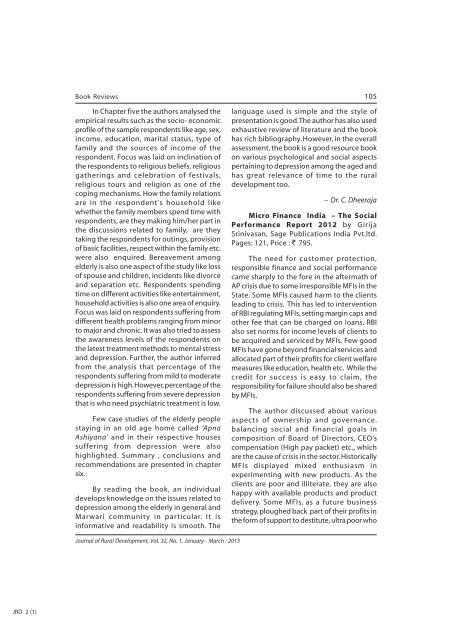January - March 2013 - National Institute of Rural Development
January - March 2013 - National Institute of Rural Development
January - March 2013 - National Institute of Rural Development
- No tags were found...
You also want an ePaper? Increase the reach of your titles
YUMPU automatically turns print PDFs into web optimized ePapers that Google loves.
Book Reviews 105In Chapter five the authors analysed theempirical results such as the socio- economicpr<strong>of</strong>ile <strong>of</strong> the sample respondents like age, sex,income, education, marital status, type <strong>of</strong>family and the sources <strong>of</strong> income <strong>of</strong> therespondent. Focus was laid on inclination <strong>of</strong>the respondents to religious beliefs, religiousgatherings and celebration <strong>of</strong> festivals,religious tours and religion as one <strong>of</strong> thecoping mechanisms. How the family relationsare in the respondent's household likewhether the family members spend time withrespondents, are they making him/her part inthe discussions related to family, are theytaking the respondents for outings, provision<strong>of</strong> basic facilities, respect within the family etc.were also enquired. Bereavement amongelderly is also one aspect <strong>of</strong> the study like loss<strong>of</strong> spouse and children, incidents like divorceand separation etc. Respondents spendingtime on different activities like entertainment,household activities is also one area <strong>of</strong> enquiry.Focus was laid on respondents suffering fromdifferent health problems ranging from minorto major and chronic. It was also tried to assessthe awareness levels <strong>of</strong> the respondents onthe latest treatment methods to mental stressand depression. Further, the author inferredfrom the analysis that percentage <strong>of</strong> therespondents suffering from mild to moderatedepression is high. However, percentage <strong>of</strong> therespondents suffering from severe depressionthat is who need psychiatric treatment is low.Few case studies <strong>of</strong> the elderly peoplestaying in an old age home called ‘ApnaAshiyana’ and in their respective housessuffering from depression were alsohighlighted. Summary , conclusions andrecommendations are presented in chaptersix.By reading the book, an individualdevelops knowledge on the issues related todepression among the elderly in general andMarwari community in particular. It isinformative and readability is smooth. Thelanguage used is simple and the style <strong>of</strong>presentation is good. The author has also usedexhaustive review <strong>of</strong> literature and the bookhas rich bibliography. However, in the overallassessment, the book is a good resource bookon various psychological and social aspectspertaining to depression among the aged andhas great relevance <strong>of</strong> time to the ruraldevelopment too.– Dr. C. DheerajaMicro Finance India – The SocialPerformance Report 2012 by GirijaSrinivasan, Sage Publications India Pvt.ltd.Pages: 121, Price : ` 795.The need for customer protection,responsible finance and social performancecame sharply to the fore in the aftermath <strong>of</strong>AP crisis due to some irresponsible MFIs in theState. Some MFIs caused harm to the clientsleading to crisis. This has led to intervention<strong>of</strong> RBI regulating MFIs, setting margin caps andother fee that can be charged on loans. RBIalso set norms for income levels <strong>of</strong> clients tobe acquired and serviced by MFIs. Few goodMFIs have gone beyond financial services andallocated part <strong>of</strong> their pr<strong>of</strong>its for client welfaremeasures like education, health etc. While thecredit for success is easy to claim, theresponsibility for failure should also be sharedby MFIs.The author discussed about variousaspects <strong>of</strong> ownership and governance.balancing social and financial goals incomposition <strong>of</strong> Board <strong>of</strong> Directors, CEO’scompensation (High pay packet) etc., whichare the cause <strong>of</strong> crisis in the sector. HistoricallyMFIs displayed mixed enthusiasm inexperimenting with new products. As theclients are poor and illiterate, they are alsohappy with available products and productdelivery. Some MFIs, as a future businessstrategy, ploughed back part <strong>of</strong> their pr<strong>of</strong>its inthe form <strong>of</strong> support to destitute, ultra poor whoJournal <strong>of</strong> <strong>Rural</strong> <strong>Development</strong>, Vol. 32, No. 1, <strong>January</strong> - <strong>March</strong> : <strong>2013</strong>JRD 2 (1)
















